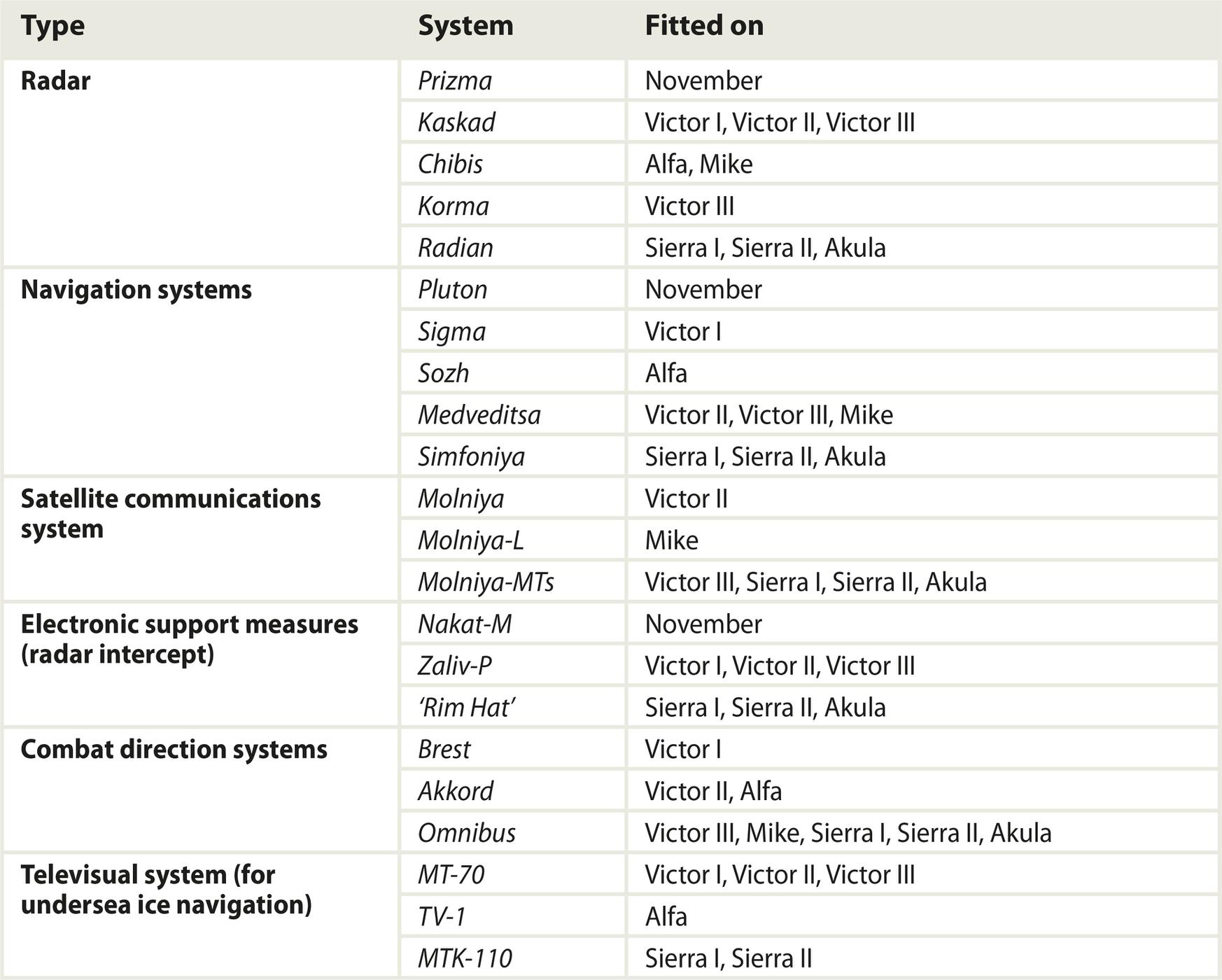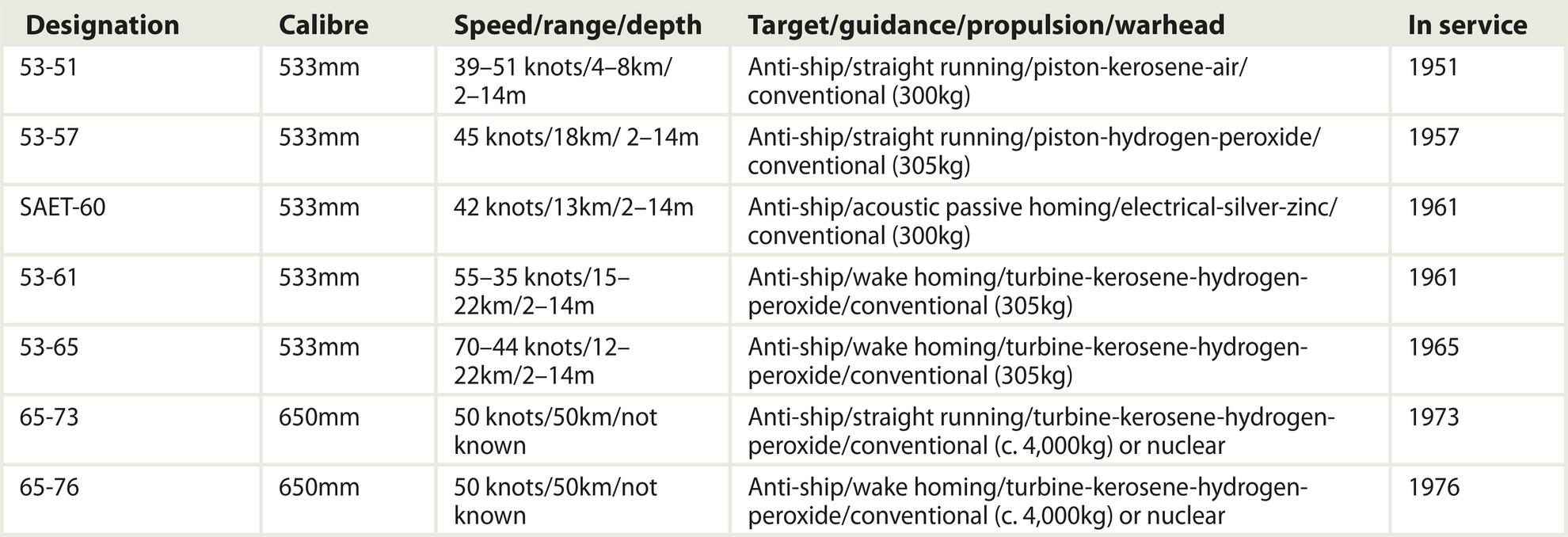
The Soviet Navy used three calibres of torpedo on their attack submarines during the Cold War. The 533mm calibre was the standard torpedo size, and all submarines had tubes of this size. The large 650mm calibre torpedo appeared in the 1970s, primarily as an anti-shipping torpedo. Victor II, Victor III, Sierra and Akula class submarines carried 650mm torpedo tubes alongside standard 533mm tubes. The 400mm torpedo was generally used as the final element within the anti-submarine missile systems developed from the 1960s onwards.
The first post-war Soviet non-homing torpedo design was a development of the 53-39 straight-running torpedo. The 53-51 incorporated a pattern-running capability and an electromagnetic proximity detonator. This in turn was used as the basis for a hydrogen-peroxide powered torpedo, the 53-57, developed from the wartime German Stein-Butt torpedo. This was also straight running, but the lack of a surface wake made it a much more potent anti-ship weapon. A nuclear-tipped version of the 53-57, the 53-68, was also developed and entered service in 1968.
The first Soviet anti-ship homing torpedo was the SAET-50, based on the German T-5 torpedo of 1943. It homed onto its target using an internal passive sound detector but was severely limited by its ability only to engage surface vessels steaming at 12 to 16 knots. A modified version with an improved battery, the SAET-50M, entered service in 1955. Soviet scientists then focused on wake-following torpedoes as a more reliable homing method: the first such torpedo being the 53-61. Wake-homing and hydrogen peroxide propulsion (which also ensured much greater speeds) were combined in the 53-65. Both types were modified in the following years (53-61M and 53-65M, the latter replacing hydrogen peroxide with oxygen). From the late 1960s, the development of anti-ship torpedoes focused on the larger calibre 65-73 and 65-76 torpedoes. Soviet planners had estimated that it could take from eight to ten 533mm torpedoes to sink a 70,000-tonne US carrier, so the 650mm torpedo provided the space for a larger warhead and propulsion to ensure greater speed and range. 65-73 was a straight-running torpedo and 65-76 was wake-homing. Both could either be armed with nuclear or conventional warheads. The SAET-60 torpedo was developed as a defensive torpedo to launch against attacking anti-submarine ships. It returned to acoustic homing and was electrically powered with a zinc-silver battery. A modified version, the SAET-60M, entered service some years later.

Anti-submarine torpedoes received less attention from Soviet designers until the 1960s when the threat from NATO attack submarines and SSBNs became apparent. The first anti-submarine torpedo was the SET-53; it entered service in 1958, was electric-driven with lead acid batteries, and had a passive acoustic homing system. It did have considerable limits to its operations: its homing system only worked within 600m, it had difficulty engaging submarines going over 12 knots underwater and could only destroy targets within the 20 to 200m depth envelope. A modified version entered service in 1964, the SET-53M. A much-improved anti-submarine torpedo had appeared in 1962: the SET-40. This had a dual active-passive homing system which made it much more effective at engaging quiet submarines. Unfortunately, its 400mm calibre limited its usefulness, although a 533mm calibre version, the SET-65, appeared in 1965. It could, however, engage at greater depths than its predecessors and was regarded as one of the best weapons of its type. The Soviets also developed two multi-purpose torpedoes, the SET-72 and USET-80. The former was a 400mm torpedo and the latter 533mm. The USET-80 was electric powered and combined active and passive acoustic homing with wake-homing.
Soviet designers soon appreciated that when firing ASW torpedoes at range (say 12,000m), their submarine targets usually had enough time for effective defensive manoeuvres to get them out of range or danger. As a result, a rocket-powered torpedo was developed in the 1970s, the VA-111 Shkval (squall) – this is described in more detail in the commentary to Plate A.
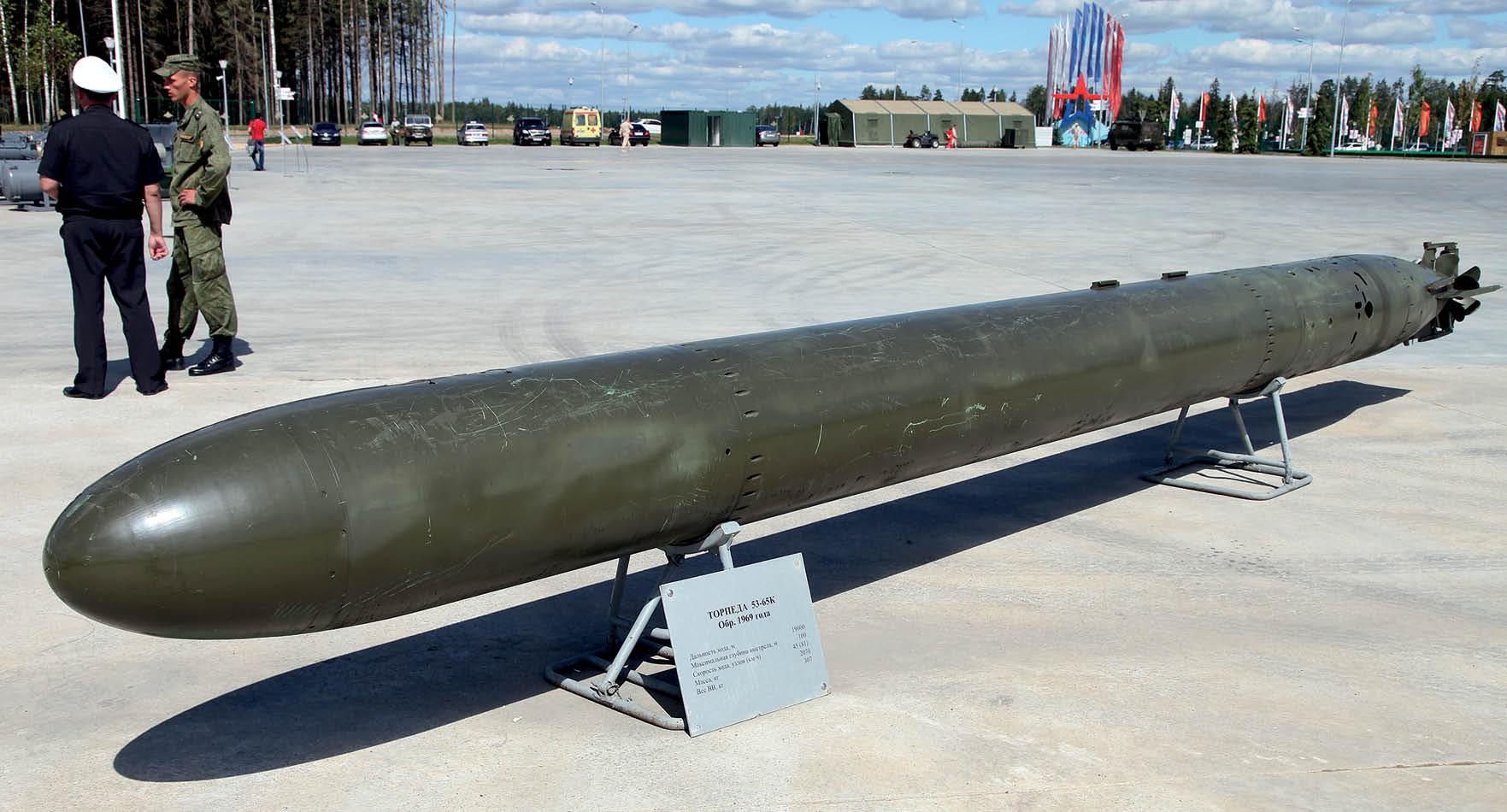
The 53-65 torpedo used its internal sonar to home onto disturbances and bubbles in the water caused by the wake of a surface ship. (Vitaly V. Kuzmin/CC-BY-SA-4.0)
The Soviets also developed a number of wire-guided torpedoes. These helped ensure a greater accuracy through active manual guidance onto a target, but did mean that the launching submarine would have to remain in the environs of its target until close to impact, thus increasing its vulnerability. The first wire-guided, anti-submarine torpedo was the STEST-68, which entered service in 1969 and was followed by the TEST-71.
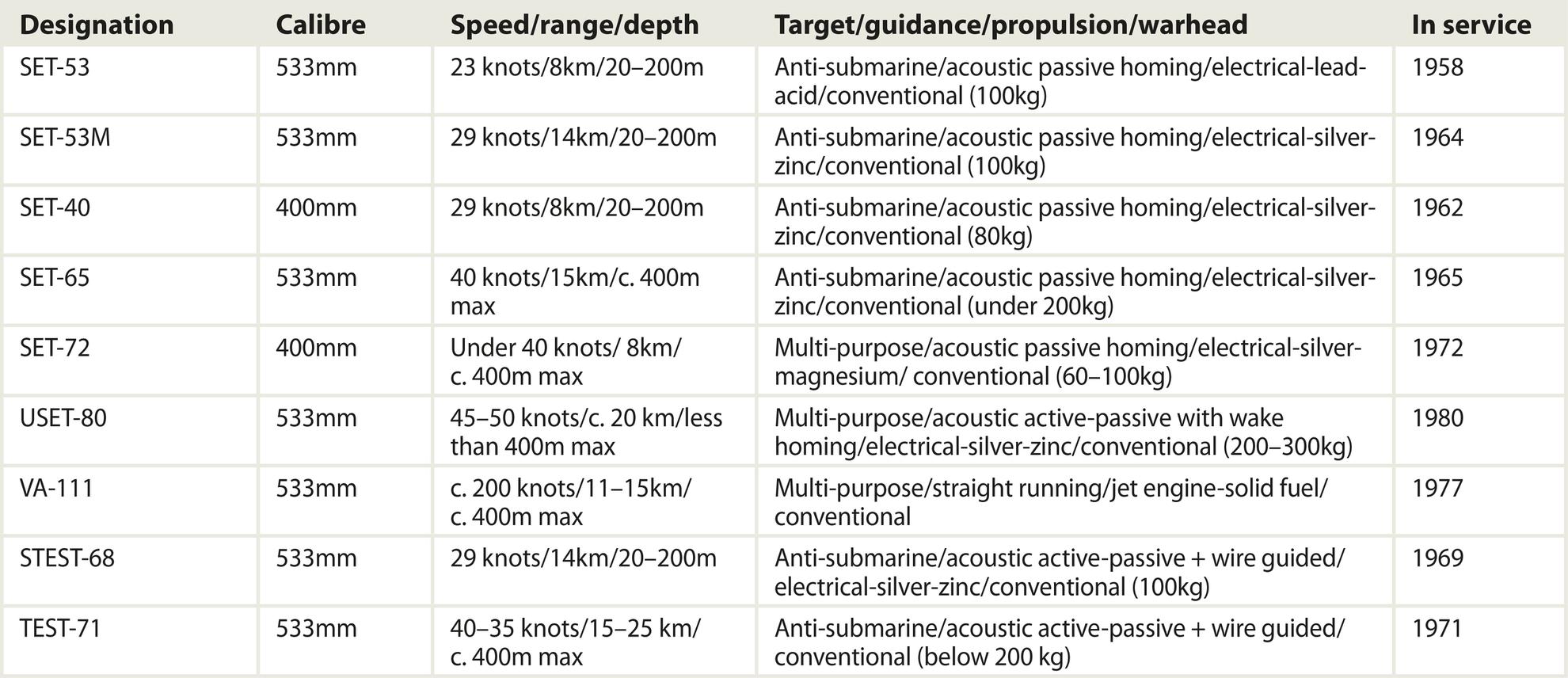
With the advent of the nuclear-powered submarine – which could travel underwater at speeds much higher than their conventional predecessors – Soviet planners became acutely aware that anti-submarine torpedoes, whether guided or straight running, would only be effective if launched at very short range. Therefore, on 13 October 1960, the Soviet Council of Ministers authorised the development of anti-submarine missiles for both surface ships and submarines. The submarine-launched variant of these missiles would be launched from the torpedo tubes of a submerged submarine, break the surface and then fly through the air to the area where the enemy submarine was located, whereupon the missile would then release a small (generally 400mm calibre) torpedo which would dive towards the target and intercept it.
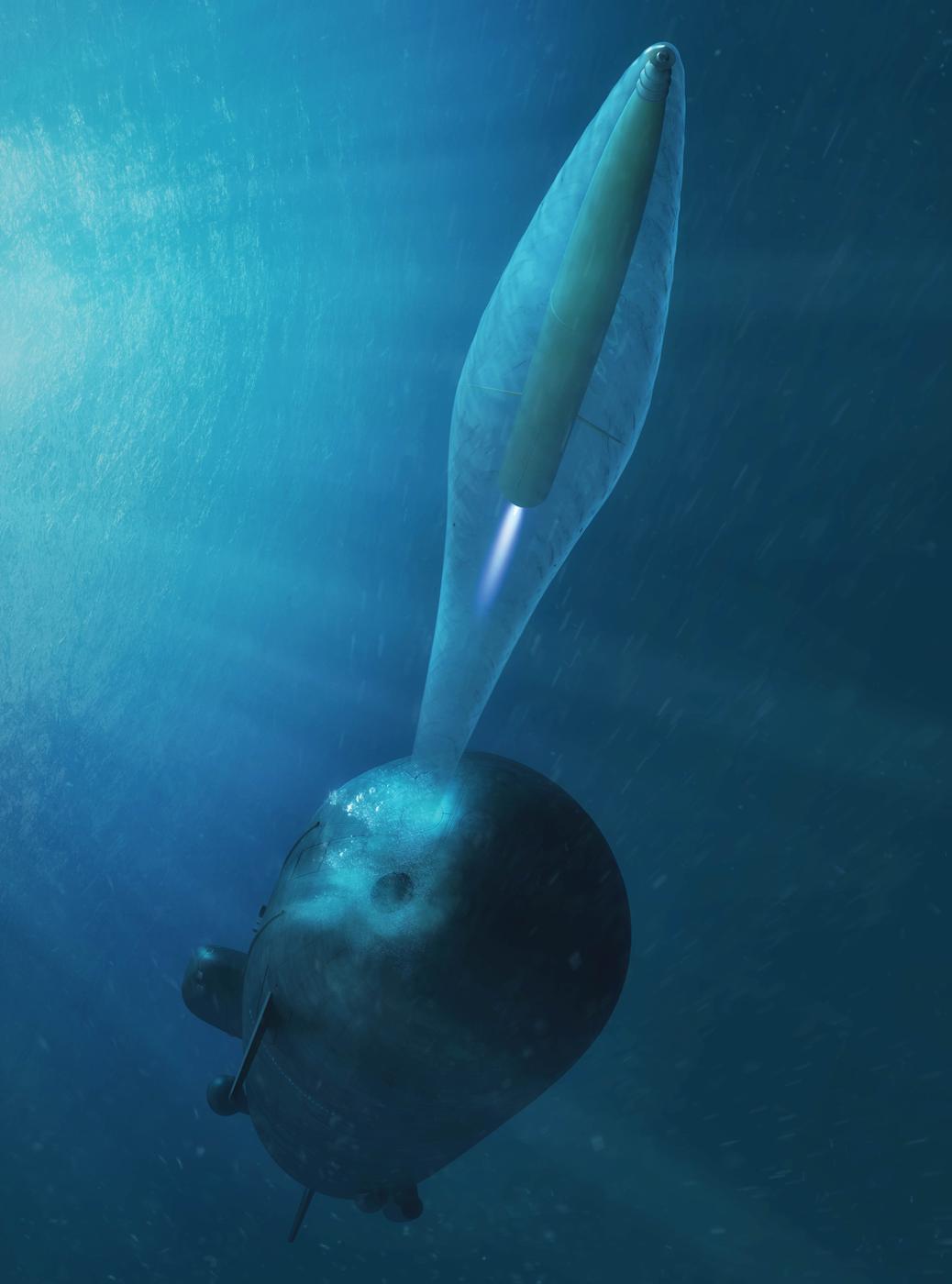
This plate shows a Victor III class submarine – the mainstay of the Soviet attack submarine fleet in the 1980s – firing a Shkval V-111 rocket torpedo. The weapon began development as early as the 1960s as a way of overcoming the relatively slow speed and short range of standard anti-submarine torpedoes. Its main role was defensive. It would be fired as soon as an incoming torpedo was detected, with the bearing of that torpedo programmed into the Shkval before it was fired. Launched from a standard torpedo tube by means of a water pulse, once away from the submarine, the rocket motor would be activated and the weapon would travel in a bubble of air (which dramatically reduces the drag on the weapon and therefore increases its speed significantly). This bubble of air is created by a series of nozzles in the weapon’s nose using air from the rocket’s exhausts; four retractable fins would stabilise the rocket. This highly ingenious system enabled speeds of up to 200 knots and would have been a formidable weapon, particularly against an attacking submarine that had fired a wire-guided weapon and would have had limited ability to manoeuvre to escape or avoid. The original Shkval would have had a small nuclear warhead and some Russian sources have stated that it was straight running without any form of guidance beyond the initial bearing fed into the weapon. Later versions have been armed with conventional explosives; an anti-ship capability has also been developed and a more sophisticated guidance system may well be installed as well.
The first Soviet submarine-launched, anti-submarine missile system was the RPK-2 V’yuga (blizzard) system. It entered service in 1969 and came in two variants. The V’yuga-53 was launched from a 533mm torpedo tube and consisted of an 81R ballistic missile, with a range of up to 35km, from which a nuclear depth charge was dropped when the missile flew over its target. The V’yuga-63 was launched from a 650mm torpedo tube and could either be nuclear armed or fitted with a 400mm torpedo.
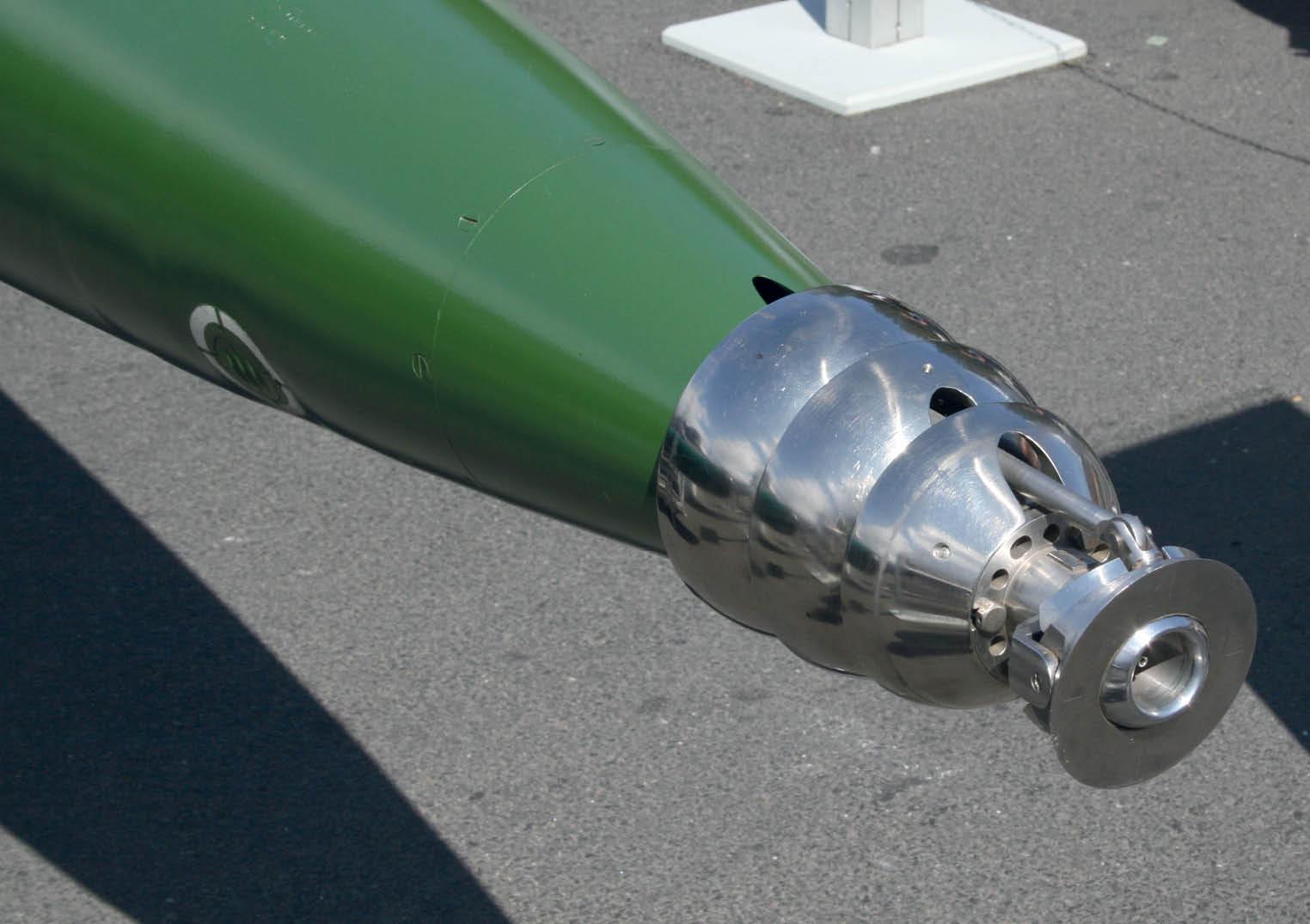
The tip of the export version of the Shkval rocket torpedo. Clearly visible is the cone mechanism that produces a pocket of air around the torpedo which reduces drag and increases speed dramatically. (One half 3544/Public domain)
After much development work, two follow-up systems were introduced. The first was RPK-6 Vodopad (waterfall), which dropped a small conventional torpedo, the UMGT-1 (speed 40 knots, 8km range, acoustic active-passive homing). The Vodopad system could launch from a greater depth than V’yuga (down to 150m below the surface) and had a greater range (50km when launched from 50m depth or 35km when launched from 50 to 150m depth). It also had a shorter weapon preparation time prior to launch, which was reduced to 10 seconds. In parallel with the Vodopad, the RPK-7 Veter (wind) system was developed which was launched from 650mm calibre torpedo tubes. Its range was twice as great as Vodopad and it could launch either a torpedo or a nuclear depth charge.
Soviet submarines laid a range of different mines from their torpedo tubes. Such mines could target surface vessels or submarines and could be triggered through a range of different methods. The Soviets pioneered the ‘rocket rising’ mine upon which, when a vessel came close, a rocket engine was started and the mine rose to the surface at great speed from its tethered mooring on the seabed. The ‘rocket directional’ mine was similar but, instead of rising, a rocket or torpedo was fired in the direction of the target (usually another submarine). The Soviets also operated ‘self-transporting’ mines, which were launched from a torpedo tube and were in fact torpedoes that, after travelling a certain distance, laid themselves to rest on the seabed, spooled out a moored mine that was then activated as per an ordinary mine. The major types of Soviet submarine-laid mine are set out below.
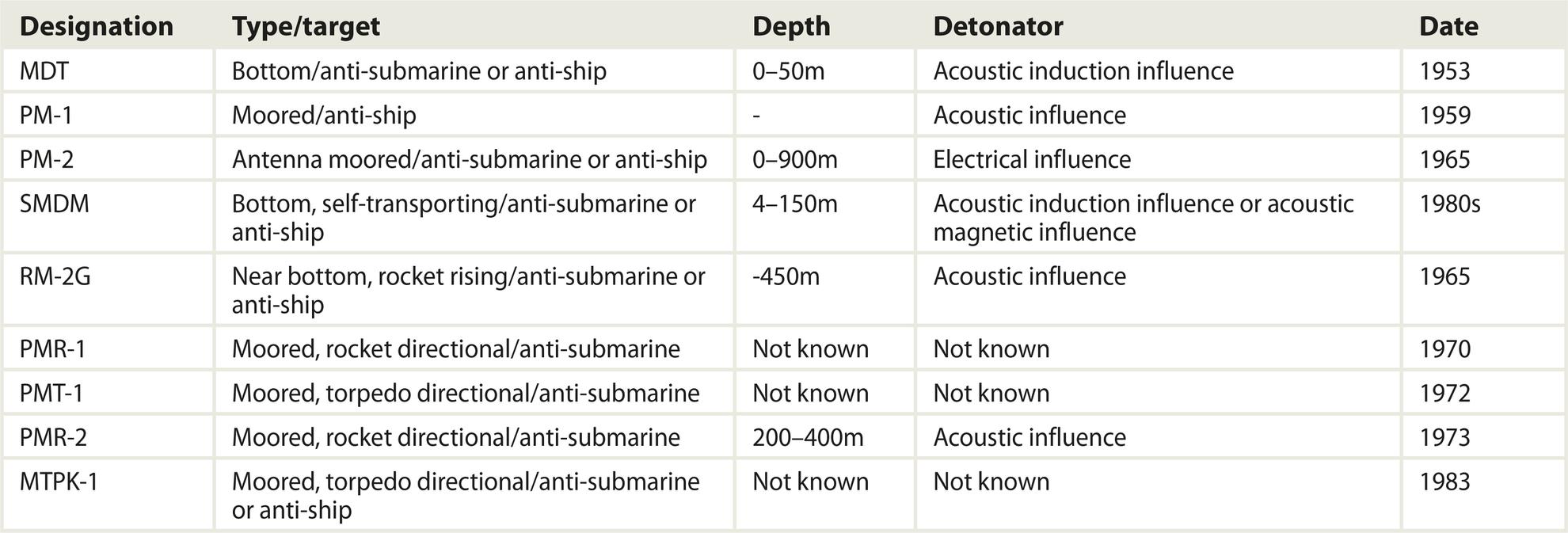
The third generation of attack submarines was fitted with the S-10 Granat (NATO designation SS-N-21 ‘Sampson’) long-range cruise missile, which could be fired from torpedo tubes and attack land targets with either conventional or nuclear warheads. In addition, second and third generation submarines were fitted with the lightweight 9K32 Strela (arrow) (NATO: SA-N-5/8 ‘Grail’) or 9K38 Igla-M (needle) (NATO: SA-X-18 ‘Grouse’) anti-air missile systems to defend the submarine from air attack if it was surfaced.
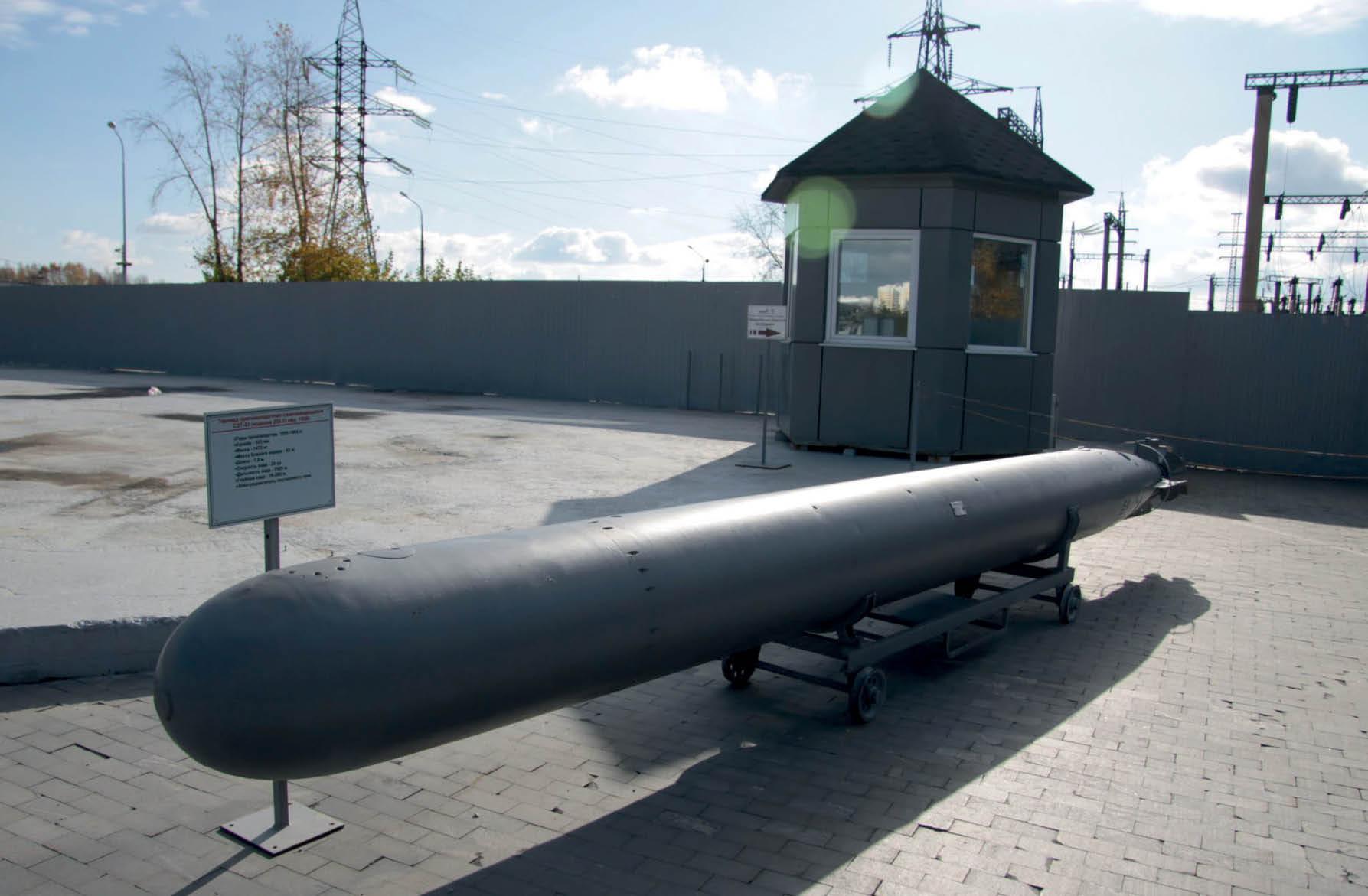
The SET-53 was the Soviet Union’s first anti-submarine torpedo. (Vladimir Sappinen/CC-BY-3.0)
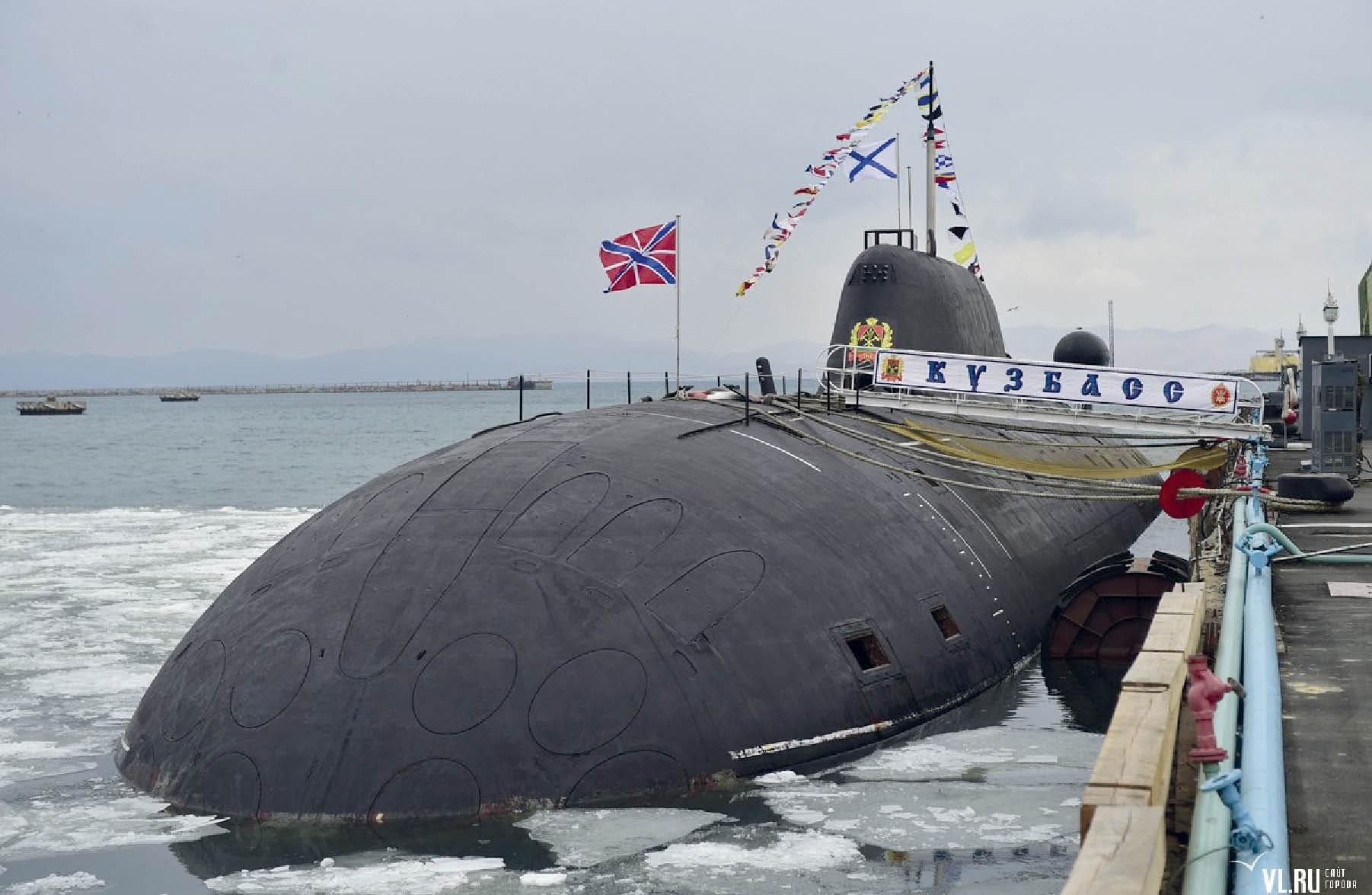
The Akula class submarine Kuzbass. Her bow openings are clearly visible: eight circular torpedo tubes are at or near the waterline, the long torpedo-loading hatch is visible on the centreline and the six U-shaped hatches are for decoys. (Istochnik – VL.ru/CC-BY-SA-4.0)
Without sonar, nuclear submarines would be unable to fulfil any of their roles, effectively being blind underwater. Soviet sonar technology made significant strides during the Cold War, as resources were poured into research and development. The first Soviet nuclear-powered submarine, K3, had a mix of sonar equipment that linked back to earlier technologies and forward to the latest developments. She was equipped with both the Mars 16KP passive sonar, the final development of a passive sonar set developed by Soviet scientists before the Second World War, and with the Arktika-M sonar. This latter sonar was an active set that had been developed in the 1950s and, for the first time, gave sufficiently accurate readings to allow surface target designation by the submarine. See the commentary to Plate B for details of the MG-10 sonar that replaced the Mars 16KP in later November class boats.
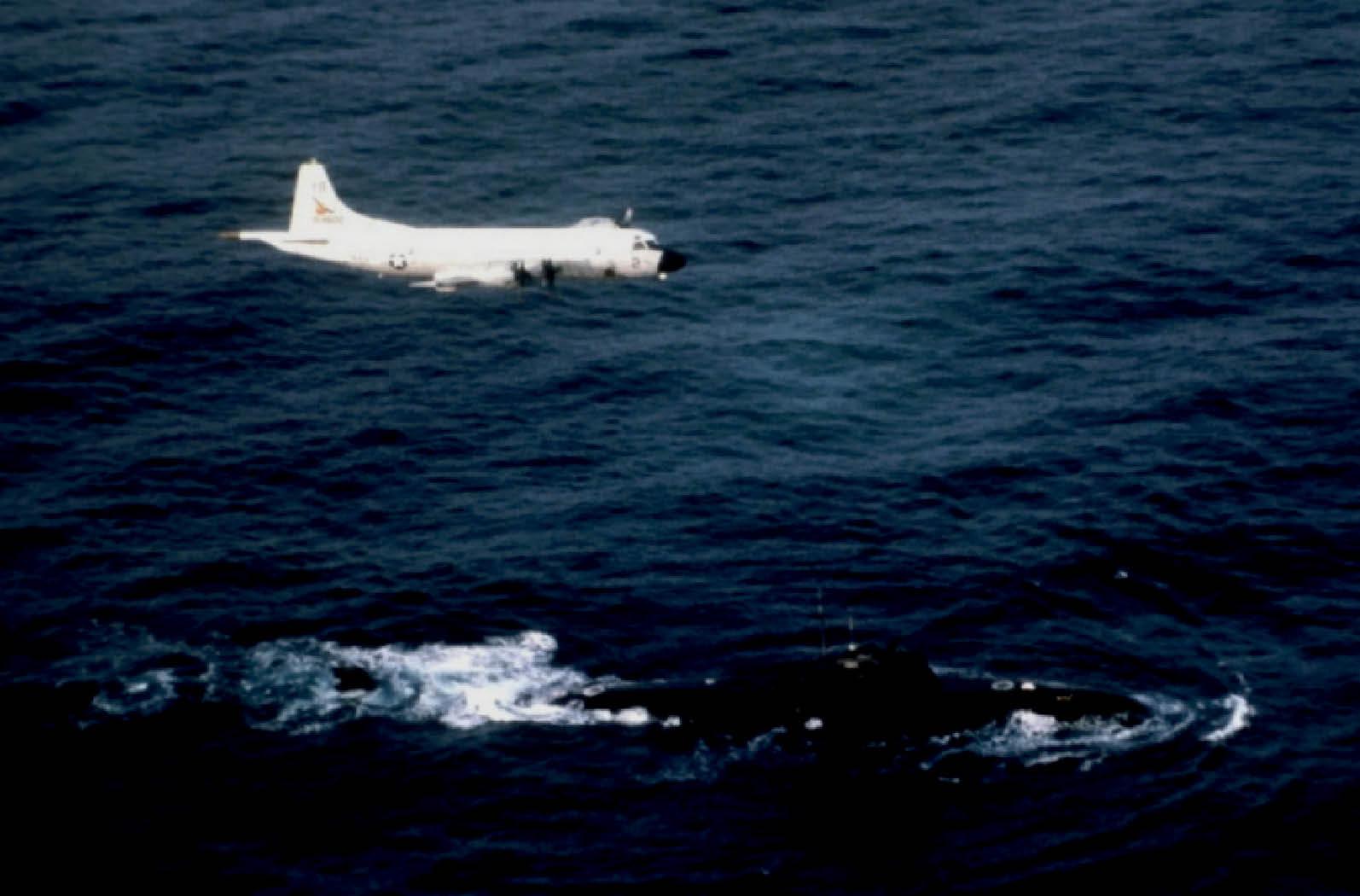
A Victor I class submarine being shadowed from the air in 1987. The Russian and Soviet navies have historically emphasised the importance of mining in naval operations. (US Navy)
There were two significant changes to the second generation of submarine sonars compared with the first. The first was that ‘complexes’ of combined sonars, both active and passive, were developed, and the second was that the main search sonars increasingly operated on lower frequencies, which dramatically increased their range by more than a factor of ten, depending on hydrological conditions. Because such sonars now operated at low frequencies, the sonar complexes needed additional high-frequency sets to detect torpedoes and mines. In addition, automated analysis of sound waves began to be included in such systems, speeding up reaction time and reducing interpretation error. The Rubin and Okean systems were of this generation, the latter combining as many as eight separate systems. Okean was also unusual in that many of the components of the system were placed outside of the pressure hull on the Alfa class boats on which they were installed, thus reducing space requirements on what was a relatively small submarine. The Rubikon sonar was built on the developments of the Rubin and Okean systems, but was installed in a special capsule in the bows of the submarine, thus isolating it from electro-magnetic fields from the vessel and allowing for a greater use of space. The Skat sonar system was the first of the third generation, incorporating yet further improvements. Initially, the requirement called for a spherical array in imitation of the US AN/BQQ-5 sonar, but as this would have required moving the torpedo tubes, a cylindrical array was chosen instead. The Skat was the first Soviet sonar system to make some use of digital, rather than analogue, circuits and was particularly successful at detecting quiet targets whilst the submarine operated speeds as high as 22 knots. The Skat-3 sonar was the next step for Soviet designers – using only digital circuits for the first time – and creating the ability not only to detect NATO submarines but also to classify targets by submarine class or type automatically.
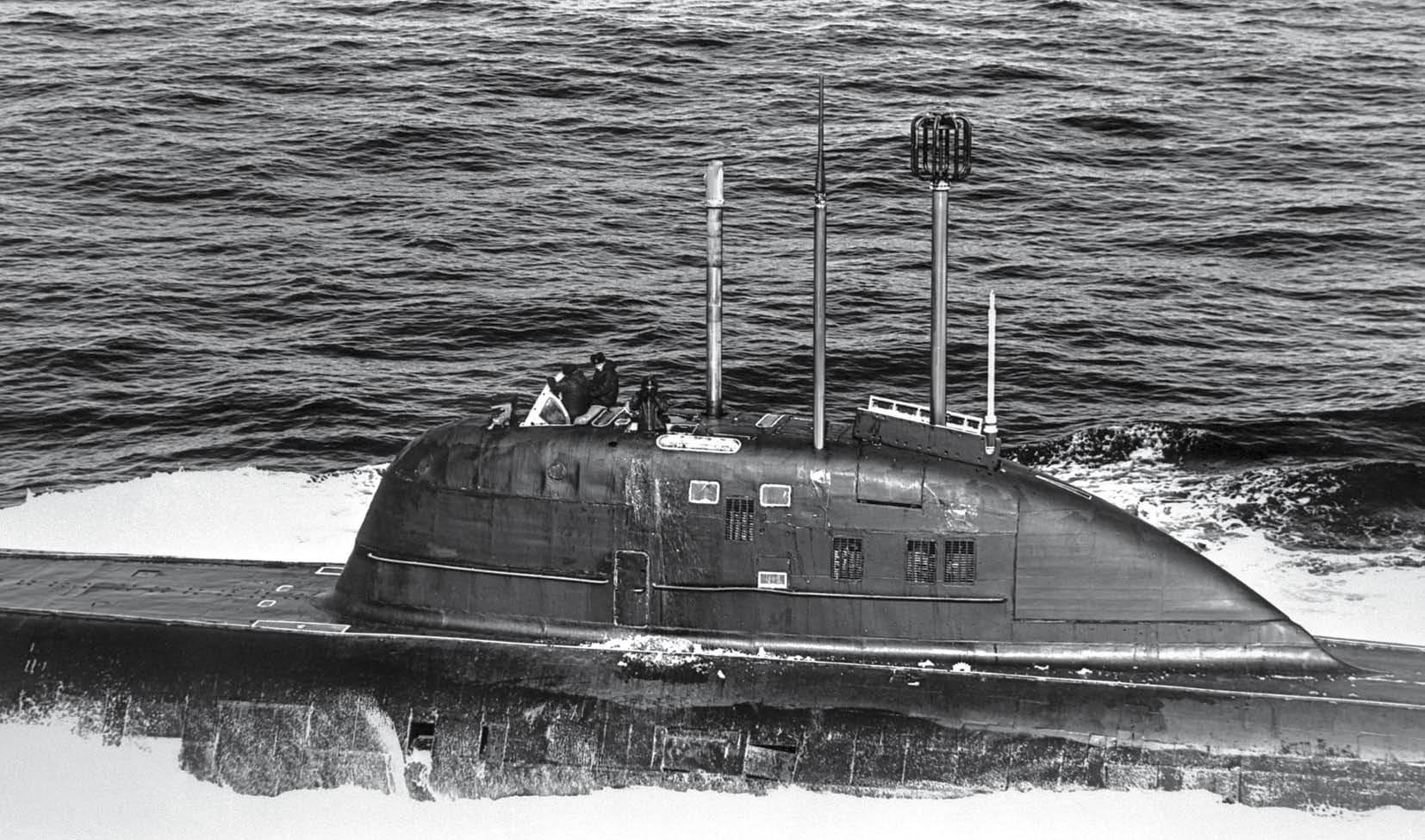
The sail and conning tower of a Victor III class submarine. Immediately behind the conning tower is the submarine’s main periscope, followed by aerials for the Kiparis, Zavesa and Anis communications and electronic systems. (US DoD)
|
System |
Fitted on |
|
Mars 16KP (passive) |
K3 only (November) |
|
MG-10 (Feniks) (passive) |
November |
|
Arktika (active) |
November |
|
Rubin |
Victor I |
|
Rubikon |
Victor II |
|
Okean |
Alfa |
|
Skat |
Victor III, Mike, Sierra I |
|
Skat-3 |
Akula, Sierra II |
